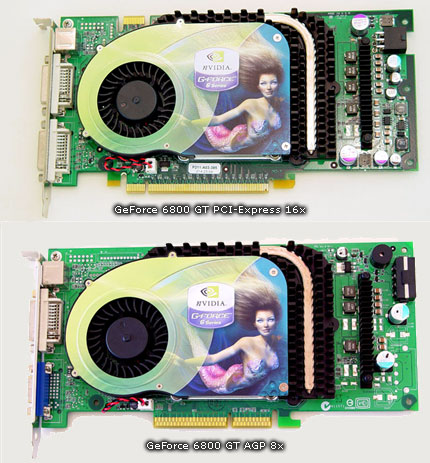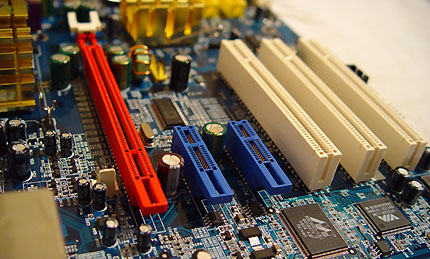PCI Express and eeuh a Photo
PCI-ExpressToday's product is of course all about PCI Express; the new development in I/O interconnect standard that companies like NVIDIA, ATI and many others will deploy in future graphics solutions. Basically it's going to replace the traditional AGP bus in the next year or two. NVIDIA won't be releasing GPUs with native PCI Express initially, but will rely on bridged solutions to handle the translation from the multiple serial busses to the card's native AGP interface. NVIDIA calls their bridge-chip the HSI, High Speed Interconnect. With up to 4GB/s of one-directional and 8GB/s of concurrent bandwidth, users are free to have high-speed graphics output. PCI Express significantly increases bandwidth between the central processing unit (CPU) and graphics processing unit (GPU).

The differences between ATI and NVIDIA (NVIDIA HSI/ ATI Native) can be discussed and argued. Ehm, it really doesn't matter at this time. Only the future will tell what is the most effective solution and most of all you need to remember this; only future generations of graphics cards will really benefit from PCI-Express. I expect to see support for AGP for another 3 years or so. PCI Express is definitely the way to go.

PCI-Express mainboard
What's the major difference over AGP then? Well see, the PCI-Express bus will no longer be a single parallel data bus through which all data is routed at a set rate. You should look at it as a series of serial, point-to-point wired, individually clocked "lanes" each consisting of two pairs of data paths that will carry data upstream and downstream. Is anyone else thinking HDTV here?
Each of these paths/lanes is capable of a 2.5Gb/s data rate in each direction making it scalable. The overall sustained transfer rate roughly equals 200MB/s. PCI-Express has been designed with future upgrades in mind. Where the real performance benefit comes in is when more than one lane is added to a given point-to-point connection. Lanes can be stacked together to increase the amount of bandwidth available to specific areas of the I/O system, such as the video card slot, for example.
This technology will have a couple of immediate benefits. First of all, the amount of trace routes on any given motherboard will be considerably reduced by the adoption of point-to-point circuitry.
In short, PCI-Express has excellent potential, it's very flexible and offers enough capability for a long time. Was the above a bit puzzling? Just remember this... lot's of bandwidth for your graphics cards to "breathe" in.
Introducing the GeForce 6800 GT
The graphics core itself is built upon a 0.13 Micron Process technology that is fabricated at IBM. As rumors suggested the 6800 indeed has a lot of transistors. I personally didn't count them but NVIDIA states that there are 222 Million transistors! Imagine all that on a 40mm x 40mm FlipChip GPU running roughly 350-400 MHz. And in case you are wondering yes... the transistor count is actually higher than a Pentium 4 Extreme Edition. Since we are on the topic of the core, there are 6 vertex units inside it. One of the biggest advantages of the Series 6 is of course the increased number of pixel pipelines. The more the faster, is the general consensus.
![Booya ! [Guru3D.com 2004]](https://www.guru3d.com/miraserver/images/reviews/videocard/6800gt-pcie/teaser-t.jpg)
